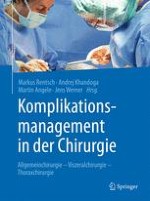Zusammenfassung
Obwohl die akute Wundversorgung global nach den gleichen Standards abläuft, die einfach und unkompliziert umzusetzen sind, kommt es hierbei nicht selten zu verzögerten Heilungsprozessen, Infektionen und sekundärer Wundheilung und damit auch zu verlängerter oder wiederholter Behandlungspflichtigkeit. Hierdurch entsteht einerseits ein relevanter ökonomischer Aspekt, andererseits können gerade scheinbar „einfache“ Wundbehandlungen zu Endlosgeschichten bei fehlerhafter Behandlung oder Komplikationen werden. Aus diesem Grund nimmt eine effiziente und insbesondere komplikationsarme Versorgung akuter Wunden einen steigenden Stellenwert ein. Die akute Situation verhindert oft eine profunde Aufklärung über die Behandlungskonsequenzen und vielfach ist für die betroffenen Patienten in dieser Situation die Tragweite der Verletzung und der Behandlung gar nicht zu erfassen, sodass Missverständnisse bezüglich des Behandlungskonzepts und -erfolgs nicht selten sind.











